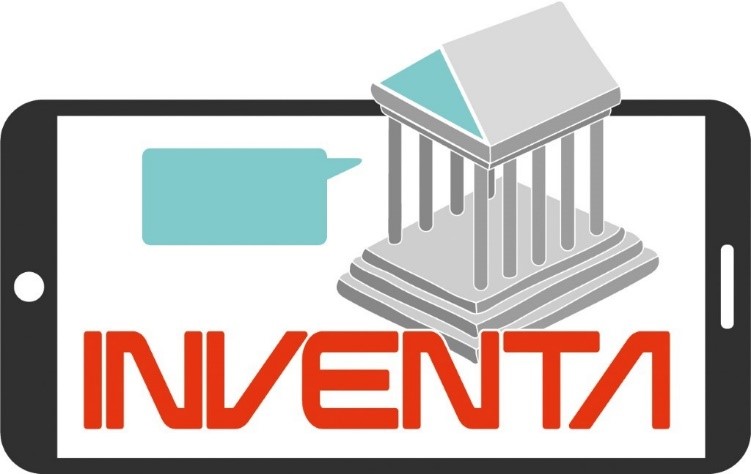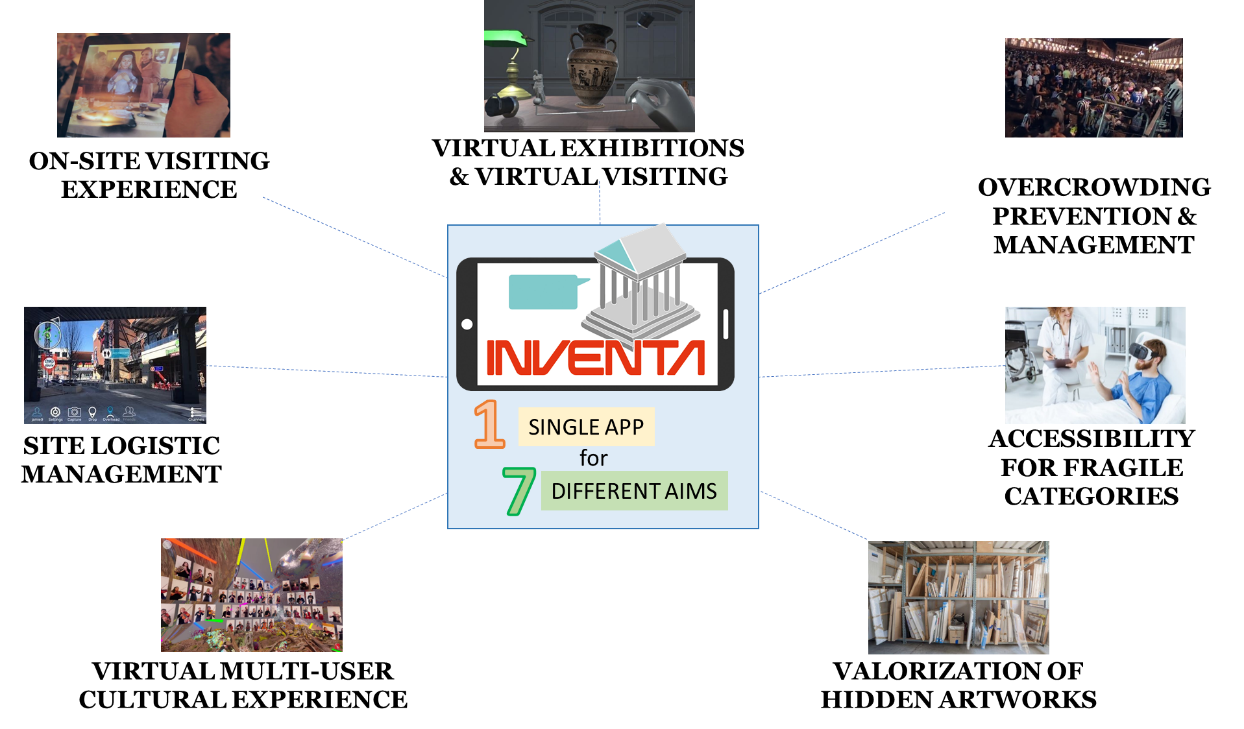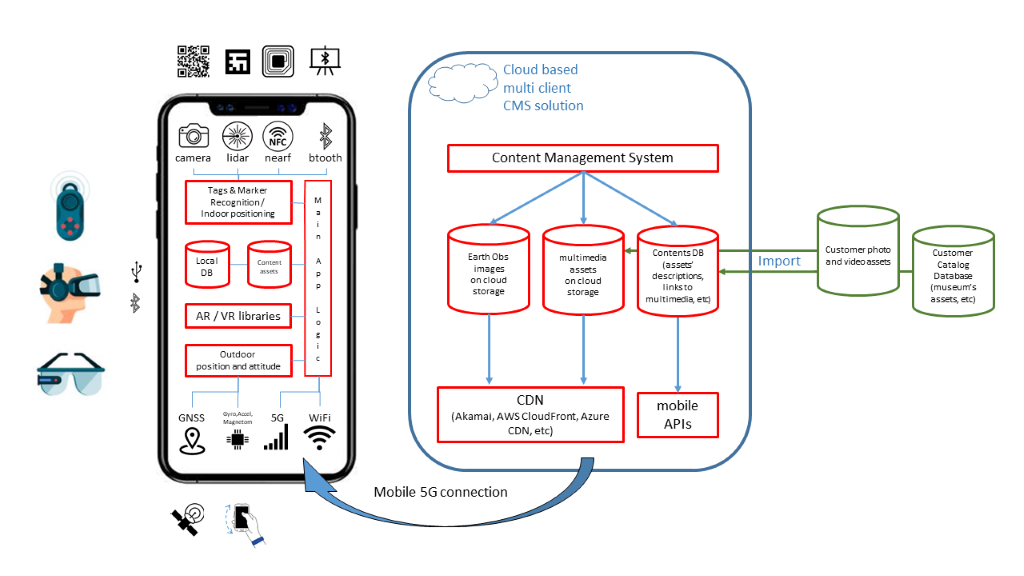
Objectives of the service

Image credit: LINKS Foundation Project: INVENTA
Digital technologies are generating a new form of valorization and protection of cultural heritage, whose fruition is no longer tied to a territorial vision, but expands towards new unlimited horizons, free of space-time constraints. It is up to us now to make the most of this possibility.
The INVENTA Project aims to explore the potential of Virtual Reality and Augmented Reality technologies combined with the 5G network and space technology (in particular Satellite Navigation and Earth Observation), to bring innovation in the Cultural Heritage sector, in particular by strengthening the following aspects:
- Fruition, enriching the visit experiences with innovative, three-dimensional, 360 ° immersive, interactive multimedia contents that can be downloaded anywhere on your mobile device;
- Accessibility, building visits with interactive guides that can be used remotely, ad-hoc tailored also for the most fragile categories of people including the elderly, disabled people, ill people, hospital patients or people trapped in quarantine by the Covid-19 pandemic;
- Sustainability, optimizing the management costs of cultural sites by complementing the physical infrastructures (signs, audio-diffusion systems, monitors, etc.) with AR-based digital components, customizable in real time on the basis of contingent information (crowds, queues, local events, promotions, etc.)
INVENTA will create a new way of living the cultural heritage world. The possibility of generating 3D digital content in any place (thanks to the 5G network) and of snapping it to a specific spatial reference context (thanks to space technologies) will produce a wide range of possibilities.
First of all, the tourist visits will be enriched by extremely engaging innovative experiences, based on augmented / virtual reality technologies and made available directly on people's mobile devices.
Secondly, the possibility of a 3D virtual logistics guide capable of retrieving spatial information in real time will significantly increase the economic sustainability of the management processes of cultural sites, reducing the costs of acquiring/installing/maintaining local devices (e.g. audio-guides) and local infrastructures (e.g. signs, monitors), digitally guiding visitors with dedicated real-time updates, announcements of events or time-limited promotions, while regulating their flows and mitigating overcrowding phenomena. Smart services such as free parking guidance will be fully managed through the INVENTA app using satellite technology and Augmented Reality, eliminating any cost for physical installations and of course the environmental footprint, and significantly reducing possible traffic congestion.
INVENTA will strengthen the possibility of accessing and experiencing cultural heritage even remotely, thus making cultural contexts more inclusive for all people, in particular for protected categories (disabled people, hospital patients, elderly, sick) and will make new business models available for museums, able to reach new groups of visitors, breaking down any geographical barrier.
These models will allow not only a more effective response from museums to the current situation of the COVID-19 pandemic, but will also be able to relaunch the role of artists, guides and professionals in cultural heritage sector who will transmit their knowledge by interpreting 3D digital avatars within virtual visiting or other multi-user cultural virtual experiences.
Users and their needs
Any stakeholder (museums, tourist agencies, municipalities, temporary exhibitions organizer, etc.) having interest in promoting any cultural element (sites, monuments, artworks, historical buildings, etc.) is a potential “Customer” of INVENTA Services.
Customers aims at offering more and more competitive visiting experiences, in particular improving the following key aspects:
- Fruition: enriching visiting experiences with innovative digital material support
- Accessibility: extending the possibility to access the cultural site to a greater and greater number of people
- Sustainability: optimising the resources needed, and/or the related costs, to manage the cultural site
With the term of “Users”, instead, we intend the people (individually, or in grouped clusters) who take benefit of the improved visiting experiences.
As “User” we see any individual who can physically access a cultural site and/or take advantage of any related digital content. Thus, Users can be distinguished into two main categories: “physical visitors” (Tourists, Citizens, etc.) and “remote visitors” (people who cannot physically reach the site, including protected categories such as disabled people, hospital patients, elderly, and people trapped at home by COVID-19 Outbreak). INVENTA takes into account not only individual users, but also users associated in groups, involving entities such as citizens associations, education institutions, or healthcare centres (who want to allow patients to remotely visit cultural heritage sites).
Service/ system concept

INVENTA service will be able to answer seven use cases:
USE CASE 1 – ON-SITE VISITING EXPERIENCE
There is a common need for cultural sites to provide new advanced visiting experiences able to re-catalise visitors attention and to grant an adequate level of resilience to COVID-19 and sustainability. In this direction, the use of digital technologies can bring a concrete added value, using novel approaches in creating educational content based on virtual, augmented and mixed reality, including gamification elements and innovative story-driven approach for narratives.
USE CASE 2 – OVERCROWDING PREVENTION & MANAGEMENT
Museums, Historical buildings, cultural sites must have a security policy to prevent and manage potential overcrowding phenomena, especially in case of major events. The use of digital technologies, combined with space assets and 5G network can support cultural institution preventing overcrowding phenomena by properly managing visitors flow with real-time measures
USE CASE 3 – VALORIZATION OF HIDDEN ARTWORKS
By virtually visiting a museum, people from all around the world can not only access exposed collections, but also visit the artworks which are normally unexposed by the museums for lack of physical space. Those artworks are equally relevant icons for our culture and represent a strong potential asset for museums which is often (or completely) not valorised. VR can strongly help museums to valorise this asset, creating new revenues and business models to be used to increase museums sustainability.
USE CASE 4 – SITE LOGISTIC MANAGEMENT
Informing visitors about cultural attraction locations, local services (e.g bars, restaurants, etc.), time-limited events, often require a lot of physical resources, including brochures printing, physical signs, distributed audio-systems to produce vocal announcements, and so on. All these options require costs acquiring, maintenance, update, dismission, not to talk about the environmental and noise pollution produced. Furthermore, they cannot be changed/updated in real-time, depending upon local trends-changing.
USE CASE 5 – ACCESSIBILITY FOR FRAGILE CATEGORIES
The attention to fragile categories(elderly, disabled people, hospital patients, ill people) and the need to give them the same opportunity of other visitors to explore, experience and enjoy the inestimable value of cultural heritage is a key aspect. VR can help in this direction, producing immersive 360° experience with specific interfaces ad-hoc tailored upon the user and his needs, who literally “brings” the users on a cultural site and allow him to visit it by remote, either autonomously or with a dedicated guide (an avatar animated by another person, guiding the user from remote).
USE CASE 6 – VIRTUAL EXHIBITIONS & VIRTUAL VISITING
Museums have been particularly affected by the COVID-19 pandemic, with more than 85,000 institutions worldwide closing their doors during the crisis. Digital means can offer crisis-resilient solutions in relation to museums’ functions, from the collection of artefacts to their conservation and study, and from the interpretation and exhibition of museum collections to marketing and to managing online and onsite visitors. There is a huge potential for innovation, experimentation using advanced technologies and for collaboration between the cultural, creative and technology sectors, in an inclusive way. Investing in digital technologies is essential for museums to innovate and to adapt to new circumstances.
USE CASE 7 – VIRTUAL MULTI-USER CULTURAL EXPERIENCE
The current pandemic situation dealt a critical hit to the social aspect of cultural experience, creating unprecedented barriers between human beings either from physical or psychological points of view. The need to restore human contact and people interoperability giving them a space to socialize following their own passions, hobbies, and cultural profession in any field (music, picture, sculpturing, education, etc.) is highly perceived. Digital technologies combined with remote connection can concretely help to preserve socio-cultural experience, allowing people to gather together transcending geographical and logistic barriers, and (thanks to 3D body tracking) experimenting new forms of communication and interaction.
Space Added Value

Image credit: LINKS Foundation Project: INVENTA
The INVENTA App will download and display AR/VR based content based on the experience logic and UI.
Full integration of the available sensors will be provided by the app. Envisioned usage is the following:
- GNSS: the app will leverage localization data to
- notify the user of specific content available
- enable gamification features
- use AR to display POI (Point Of Interest) information
- enable usage of Galileo’s high precision positioning on dual-frequency HW equipped devices
- camera, lidar, NFC, Bluetooth: to enable indoor positioning and image recognition of masterpieces / cultural assets
- USB-C port: to interface compatible external AR/VR viewers
- IMU components: (such as gyroscope, accelerometer, magnetometer) to enable smoother AR behavior and gamification features
- 5G: faster connection speed will be leveraged to
- enable download and fruition of higher quality streaming content such as 360° visualizations of cultural assets
- enable interactive features for gamification and interaction with museum guides such as live QA
The main space assets foreseen for integration include specific Satellite Navigation System, in particular Galileo (GNSS) to provide high precision positioning capability. The system currently consists of 22 satellites in operational conditions and the complete 30-satellite Galileo system (24 operational and 6 active spares) is expected by 2020. Earth Observation satellites assets will be used as well to obtain high resolution images of the terrain.
Satellite navigation will in particular be used to communicate user location to the server (to enable it downloading and transmitting the specific data related to the user area) and to trigger different AR/VR content once user reach a specific location.
Earth Observation will in particular be used to get terrain images (e.g. vision of the monument/cultural site/area from the sky, by day and by night), to be stored in the server and transmitted together with the other data (AR/VR content & logistic information) to the users mobile devices, giving further option to enhance cultural heritage fruition (sky perspective of large monument/historical buildings, night sky visions, map of large outdoor areas, etc.).
Current Status
Customers & Users Engagement
- 126 Users and 30 Customers actively replied to INVENTA, providing data for INVENTA Data Collection
- Two customers in particular (Turin City and Associazione Abbonamento Musei, the inter-regional authority responsible for museums season ticket selling in Piemonte & Val d’Aosta regions) dedicated a INVENTA webpage on their website.
- Four Customers in particular (Compagnia di San Paolo, Associazione Abbonamento Musei, Turin City, Fondazione Torino Musei) promoted INVENTA investigation distributing INVENTA Questionnaire through their users’ network.
- Fondazione Torino Musei agreed in dedicating INVENTA mock-up to create the first remote virtual multiplayer visit of Palazzo Madama in Turin, with particular focus on the mostra “Ritratti d’Oro e d’Argento”. They also agreed in promoting the mock-up in a final event, if COVID-19 restrictions will allow it.
Technical Feasibility
The technical feasibility of INVENTA System was validated in regards to the following components:
- Satellite navigation/GNSS capability
- Satellite earth images availability in different resolutions to fulfil selected use cases
- 5G network/devices availability to ensure high speed data transfer and low latency
- Feasibility of assembling adequate CR/AR contents, products and frameworks mastering
- Content management, mobile and cloud development skills availability
Economic Sustainability
In regards of the economic sustainability of INVENTA System, the following elements are worth to be mentioned:
- The preliminary market, competitive and value chain analysis highlighted promising market opportunities for INVENTA (first of all in Italy), thanks to its unique combination of technologies leveraged and features provided
- An ad-hoc business model has been prepared, leveraging the Business Model Canvas methodology. It includes all the elements relevant to describe how INVENTA will create, deliver and capture value
- Starting from the above-mentioned analyses and business model, we stared to identify the main economic/ financial indicators (e.g., Break Even Point, Net Present Value and Internal Rate of Return)
- An INVENTA business plan is being prepared to provide a solid evidence of the INVENTA economic feasibility




